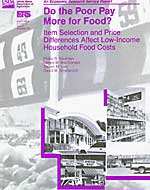Do the Poor Pay More for Food? Item Selection and Price Differences Affect Low-Income Household Food Costs
- by James M. MacDonald, Steve M. Lutz and David Smallwood
- 12/1/1997
Overview
Low-income households may face higher food prices for three reasons: (1) on average, low-income households may spend less in supermarkets--which typically offer the lowest prices and greatest range of brands, package sizes, and quality choices; (2) low-income households are less likely to live in suburban locations where food prices are typically lower; and (3) supermarkets in low-income neighborhoods may charge higher prices than those in nearby higher income neighborhoods. Despite the prevailing higher prices, surveys of household food expenditures show that low-income households typically spend less than other households, on a per unit basis, for the foods they buy. Low-income households may realize lower costs by selecting more economical foods and lower quality items. In areas where food choices are limited due to the kinds and locations of foodstores, households may have sharply higher food costs.
Download
-
Entire report
Download PDF
We’d welcome your feedback!
Would you be willing to answer a few quick questions about your experience?

